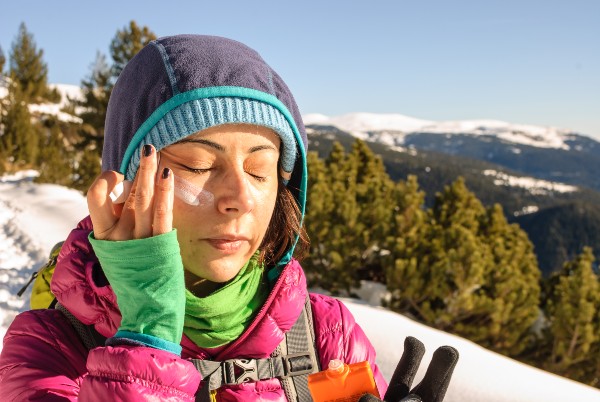By now, the hot, sunny days of summer are just a memory for most of us. But that doesn’t mean you should skip the sunscreen.
“Many people don’t realize it, but the sun can burn and damage your skin all year round – even in the cold winter months,” explains Caroline Segovia, FNP-BC, a Family Nurse Practitioner within the Riverside Cancer Care Network. “The sun’s ultraviolet rays break through cloud cover and fog and reflect off the ice, snow, water and cement. Those ultraviolet rays put you at risk for developing skin cancer and premature aging.”
No matter what time of year it is, when ultraviolet rays from the sun hit your skin, they damage the DNA in your skin cells. Ultraviolet B (UVB) rays cause sunburn and skin cancer. Ultraviolet A (UVA) rays are responsible for wrinkles and other long-term skin damage and may also be a factor in certain skin cancers.
How the sun’s rays damage your skin in the winter months
It’s true; the sun’s UVB rays are strongest during summer. However, during the winter months, UVB rays can damage your skin in ways you might not realize. According to the Skin Cancer Foundation, the snow reflects up to 80% of the sun’s UV light, for example.
“Whether you’re outside taking a walk or skiing in the mountains, the sun’s rays hit you twice – shining on you from the sky above and bouncing off the snow, sand, pavement or grass on the ground below. You get double the sun exposure,” says Ms. Segovia.
So, even though the weather may be cool, it’s not surprising when you or your children get sunburned faces after a day on the ski slopes or outdoors at play. Also, when you’re outdoors at higher altitudes, more radiation can reach your skin, increasing your risk of sunburn and skin damage.
Meanwhile, the sun’s UVA rays can penetrate through clouds and fog, even glass. People at higher altitudes , where UVA light is intense, are at greater risk for developing skin cancer.
How to protect your skin during the winter months
Be aware that UV rays tend to be strongest from 10 a.m. to 4 p.m.
To protect your skin:
- Wear sun protective clothing, including long sleeves and pants. Some specialty clothing and outdoor gear are made with an ultraviolet protection factor for extra protection.
- Wear hats to protect your scalp (and to keep you warm). Consider hats with a wide brim to help protect your face too.
- Wear sunglasses that block the UVA and UVB rays to protect your eyes.
- Apply sunscreen to your face, lips, neck, ears and hands – plus any other areas not covered by clothing. Choose a sunscreen with an SPF of 30 or higher. Reapply every two hours.
Protecting your skin all year round is important no matter what your skin type or tone. And it’s especially important if you have a family history of skin cancer.
If you’re concerned about skin damage, make an appointment with a Riverside provider.



